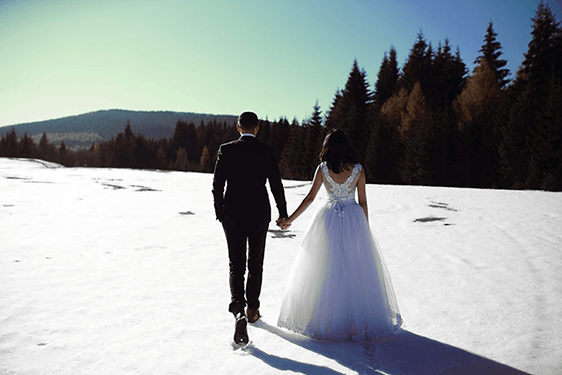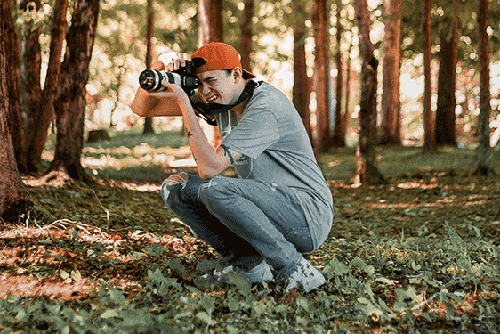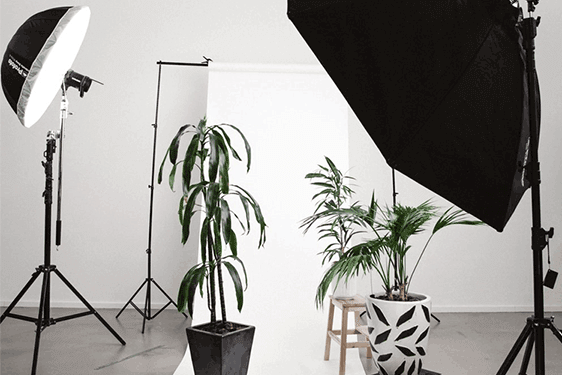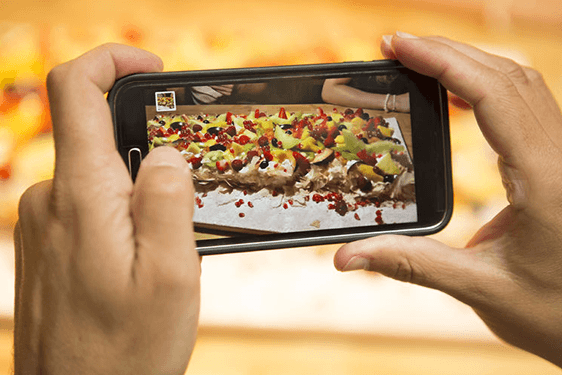Trends come and go, especially in photography. What are the top winter wedding photography trends this winter?
If you are tying the knot this winter, you will be hiring a professional wedding photographer no doubt. But what photographic results do you want? Follow the latest trends…
#1 Social media savvy
Weddings are full of photo opportunities and the winter light which is slightly bluer in tone than the golden rays of summer makes an amazing backdrop to wedding photos.
As well as your professional photographer, catch the essence of the day through the eyes of your guests by asking them to ‘snap and share’ on a dedicated social media channel. Our choice would be Instagram, a place where photos can be shared for years to come.
#2 Less formal ‘setting’
At one time, the only real option when it came to wedding photos was lining people up in family groups and snapping away.
Today, the trend is to have a less formal setting for your official wedding photos. You will, of course, want to record who is at your wedding so why have smaller group photos in the reception as well as immediately after the ceremony.
#3 Brady Brunch style photos
Take a look online at the Brady Bunch and you’ll see the type of photo style we mean. Effectively, your photographer takes individual photos of your main wedding party, with them usually relaxed and ‘giggling’, rather an awkward passport photo.
It is a way of capturing the characters and personalities of your wedding party, whilst also being able to capture the essence of your day.
#4 Stop-Motion
Stop-motion photography is a creative play on your big day that you will love. It is a combination of still photographs which are animated and set to your choice of music – and frankly, a delight to share with family and friends.
A creative photographer will see all kinds of opportunities but it may take between 10 and 20 still images laid against a moving background. Fantastically artistic, it is a really modern way of adding something different to your wedding photos.
#5 Bridal portraits
To be honest, the bride’s portrait never really went anywhere but having said that, in the midst of such a busy day, the obvious can be forgotten.
A portrait of the bride in her beautiful wedding outfit could be one of those ‘forgotten’ photos. Allow an extra half an hour at least, as you get ready to walk the aisle to your lifelong partner, to have your portrait taken.
Choose a relaxed setting where you feel at ease and the photographer can capture your personality.
And this isn’t just a portrait assigned to one partner – a portrait of your other half is also worth a thousand memories.
#6 Capture the ‘first look’
The other aspect of wedding photography in recent years is the ‘first look’. Your wedding photographer can capture the moment your other half catches sight of you in your wedding outfit. For most couples, this has tended to happen at the ceremony but with it being such an intimate and romantic moment, many people decided to capture it away from the glare of their guests.
As well as first look moment between the happy couple, many brides are also capturing the first look moment between the bride and her father, mother, step-dad, step-mum, significant figure in their lives too.
#7 Using family photos at the wedding
Wedding photography is not just about capturing the essence of your day but about how it fits with the history of the families being united together.
As well as your own amazing wedding photos, create an artistic display of family weddings from the past for guests to enjoy.
We’ve seen some great display ideas too, the best being the creation of a family tree using wedding portraits and other wedding photographs.
#8 Make the most of the winter light
It may be winter and it may be grey skies but nothing can dull the romance of outside wedding photographs. Use the beautiful watery blue light of winter, the bare branches of the tree adding drama and form, as well as your wedding venue setting for the perfect setting.

BONUS – Photograph the proposal
If you are planning on dropping down to one knee at some point in the near future, a top trend is to have the proposal photographed. Find a professional wedding photographer who will hide away in a designated spot and time to catch the ‘yes!’.
Are you interested in advancing as a photographer?
If so, have a look at some of the below resources to help you get started:-
Portfolios are essential for any creative career. Find out how to make your photography portfolio stand out from the rest.
Step 1 – Consider your audience
Anyone in a creative industry, photography included, should keep an up-to-date portfolio of their work but that doesn’t mean taking more photos and lumping them all together in a photo album.
In essence, a portfolio is a showcase of your varied photography talents, from capturing informal shots to setting up atmospheric landscape photos.
Think of your portfolio as a tool.
In most cases, you will use it as a means of securing a job or assignment.
And that means you need to consider your audience – what do they want to see? If you are applying for newspaper work, consider what it is editors would want to see, for example.
Step 2 – Choosing the photos
It isn’t a case of putting every photo you take into your portfolio. What it is, is a snapshot (no pun intended!) of what you can do and where your skills and talent lie.
There are many ways you can build your perfect portfolio and it may be that for each assignment you apply for, you will need to make tweaks to it so that the important selection of photos come first.
In other words, once you know your audience and what they are looking for, you would put these photos higher up the order and leave some of your artier stuff to the back.
Don’t shy away from including photos in your portfolio that don’t all fit what the client is looking for. You want to show you have a wider range of photography ability that they are looking for, as well as suggesting some ideas outside of the box.
How many photos should you include in your portfolio? There is no minimum or maximum number but too many, and you’ll find your client won’t look at them all. Look at step 3 for how to encourage people to really view your work.
Step 3 – Online or printed portfolio, or both?
We live in the digital age and for the photographer, this is both a blessing and a curse. But it doesn’t mean that one is better than the other.
When it comes to the best format for your portfolio, it may be that a combination of both print and online could work;
- Print – by printing off a photo book from an online retailer, you have a tangible record of your photos that you can use for assignments or for employment roles as a photographer. They also make a pleasant memory for yourself of your earlier work or work relating to certain subjects or genres. Updating on a regular basis can be expensive, however, in terms of print costs.
- Online – there are many photo-rich sites you can use to steadily build a portfolio that anyone can view. Maintain it well, and you have a vibrant record of the type of photography you enjoy delivering. As your portfolio grows, you can upload images, organise pages and sections etc., making it easier for people to navigate through it.
Step 4 – Your own website

It is really worth taking a closer look at all that is involved with displaying your photos online, especially in copyrighting your images so that they cannot be used without your permission.
There are many aspects to consider when creating a professional photography portfolio online, and it isn’t just about the photos.
As well as taking time to make sure your photos look fantastic, you will also want to consider the format of your website, and any content you use to describe photos, introduce yourself and so on.
Step 5 – Keep shooting, keep evolving, keep learning
Treat your portfolio as a living entity. It should be regularly updated and nurtured if you are serious about using it as the tool for bringing in more commissions and work.
Creativity never stands still and neither will your learning. Push your creativity to its limits, stepping outside your comfort zone to show that as a photographer, you are always willing to take risks.
There is a range of online photography courses that can help you develop your photography skills, a great way of exploring new ways of taking photos and expanding your style base too.
And finally, you just need to keep taking photos, keep exploring new ways to build your portfolio to show a wide range of photography skills.
Many people dream of being a professional photographer but just how do you get started? We take a look at how to get started in creating a professional photography business that has all the ingredients of success.
EVERY business needs a plan
No matter what the business, it needs a plan. This means that as well as photography skills, you need business skills too.
Here’s a snapshot of what a business plan should contain;
- A summary of your business – what services you provide and what makes your business unique. In other words, you are setting out the commercial viability of your business.
- Aims – these are the goals of your business. In other words, what are you aiming to do in the first five years of your business? Is it set up a photography studio or create a string of photo booths for parties and weddings?
- Objectives – these are ‘tighter’ than your business aims in that these are the statements against which you measure the success of your business. There is a lot written on business objectives but as a starting point look at how to make objectives SMART.
- Finance – you will need to be clear about financing your business too, where the money will come from, how cash flow will be managed and so on.
A business plan is the projected route of your business to success and for any new business, having a detailed plan is essential (but no guarantee of success!).
Your photography specialism
A professional photographer offers a particular service such as landscape photography, wedding photography, portraits and so on.
The professional photography market is a crowded and competitive place but that doesn’t mean that with vision, commitment and talent you can’t make an impact and have a successful business.
By offering a specialism, you are appealing to a niche market and for you, that means understanding your customer demographic.
What is ‘customer demographic’?
Customers demographic is an overview of who your customers are – their age, gender, income, occupation, wants and needs etc.
Build your portfolio
Getting a start in a creative industry can be tough, especially if you don’t have anything to show potential clients.
With photography, building a portfolio is a stepping stone to getting your first commission. By building a portfolio, both in print and online, you show potential customers you do have the photographic talent to deliver what they want.
Marketing
Every business needs customers – and a constant stream of both new and returning customers – and a steady flow of cash through the business.
When you start a business, deciding what to spend your limited budget on can be problematic. But with your business plan and your customer demographic defined, you are in a stronger position to create a marketing campaign that hits the right people.
Research what opportunities there are to push your business in front of the right people. As well as online marketing such as social media, pay per click ads so that customers find your website and so on, consider offline marketing tools too, such as booking a stand at a wedding fayre.
Expand your skills – photography and business
You will need your business head to push your business forward and into a successful arena, just as you will need strong photography skills.

- Get started with an online photography course – get the basics of photography covered with a course that sees you develop and hone these skills. From this, you can expand your field of learning with specific courses in your chosen photography area.
- Get started with basic business skills – alongside photography courses, take a look at online business management courses that help you write your business plan and projections for your business. You will need these if you decide to seek funding etc.
- Local business support – the government along with many local authorities want people to start and run successful businesses and as such, offer a free service for advising on business plans and other essential business skills and tools. They can also provide you with advice in relation to funding too.
Stick with it!
Starting and running your own business is a big step. If your dream is to become a professional photographer, here’s the good news – it can be done! – but here’s the tough lesson: you need to be committed, focused and passionate about what you do and what you can offer.
Is it your dream? How will you make it a reality?
Photography is an interesting and creative skill to have. Photography has changed so much since its invention – you’ll be surprised at just how much it has changed.
Until recently, taking photos meant hoping that what you saw in the viewfinder of the camera would be replicated on the printed photo.
You took photos until the film reel was full, you carefully took it out from the back of the camera so as not to expose it to light and sent it off to be developed. In the height of summer, when everyone sent their holiday films to be developed, you could wait up to two weeks before your photos arrived.
And then pharmacies started their ‘hour developing’, meaning that no longer did you need to wait weeks for your holiday snaps to be returned only to find that out of a role of 27 photos, only two or three were any good.
Today, we live in a very different world of photography.
The concept of photography
As a concept, the art of capturing a moment in time has been around since the 5th Century but it wasn’t until the creation of the camera obscura in the 11th Century that photography was really born.
But the 11th Century camera didn’t take a snapshot but rather reflected an image on another surface. And it was upside down. But the basics were there…
1830s
In the 1830s, Joseph Nicephore Niepce used a pewter place, light and bitumen, and the camera obscura to capture the first recorded image that did not fade.
This success led to all kinds of changes and experiments;
- Daguerreotype – this was the use of copper plate coated with silver to capture a moment in time. It relied on exposure to light and the reaction with iodine vapour as well as the copper plates. It took 15 minutes to capture the shot – imagine holding the same pose for a quarter of an hour.
- Emulsion plates – these came next and were used mainly for portrait photography. There were two types – tinplate and ambrotype – and instead of posing for 15 minutes, these wet plates took only two or three seconds of exposure to capture the photo.
Dry plates
From the 1870s onwards, photography came on leaps and bounds with the development of the box camera. This was the start of what many of us remember as 35mm but this didn’t come about until the 1940s.
However, by the mid-20th century, photography was no longer just for those who could afford the expensive and very big cameras. With the box camera, ‘ordinary’ people could start to take their own photos.
Photography and war
The world has seen and continues to see, conflict and war. The Second World War was a major conflict that changed the course of human history and in more ways than you think.
For example, the closed-circuit television (CCTV) that many of us rely on to keep our homes and businesses safe, as well as monitor manufacturing processing and production lines, was first used during WWII.
The Germans wanted to monitor the take-off process of the V2 rockets that they planned on sending over the London and did so with what we now know as CCTV.
The smaller, 35mm cameras were used widely by both war photographers during WWII and some troops too that captured the horrors of war. During this time, photography and tools we used, including film, rapidly developed to capture in black and white the human story behind the war.
Image control
With film the main vehicle for capturing images, it wasn’t long before it started to be refined.
The introduction of colour in the late 1960s and 70s meant that we started to have an appreciation for image control, although some of these early colour photographs presented us with some rather odd colour combinations!
From the 1950s onwards, the pace of change in the world of photography was huge with Pentax and Nikon coming to the market as major photography equipment brands.
As well as developing the SLR models, Polaroid was also pushing the boundaries of instant photos with their cameras. Although expensive, it started the idea that taking photos didn’t need to be something that we needed to wait for results.
The digital age

But today, many of us are taking selfies and snapping away on our digital cameras, using Photoshopping software to make subtle changes to the final photo.
Cameras are everywhere. They are small, powerful cameras on our phones and small cameras that we take on our travels with us.
Kodak produced the first film-less camera in 1991 and since then, we haven’t looked back. And people are enjoying photography too. And if you do, you too may want to enrol onto one of the many photography courses online on offer.
Other people do it – writers write, bakers bake, chefs create tasty culinary creations – they successfully follow their passions, turning it into a thriving career. But how did they manage to do so? What skills do you need to turn your passion for photography into profit?
Skill and Business Acumen
In order for anyone to run a thriving business, they need to have a developing sense of business acumen, and understanding of how to turn what they do into something people want and thus, turn a profit.

There is no magic formula. What works well for one person may not yield the same results. It depends on the market, the customer demographic, the need and desire for your products or service and the state of the market and economy at the time.
It takes hard work and commitment, all of top of your passion and skill as a photographer. But there is a market for photography and professional photographic service from wedding portraiture to commercial photography.
1) Start Small
Take a moment to read about successful solo entrepreneurs or those that now run successful companies and you will notice a common theme. They started small, with some solopreneurs starting their business alongside their full or part-time employment.
It takes time to build a customer base too and within photography, it is about building a solid reputation for delivering quality images and a great service.
Key Points
- Be flexible with your photography business taken on projects that build your portfolio and reputation as a reliable and skilled photographer
- As your business grows, consider flexible or part-time working to accommodate your growing business without placing you on the brink of bankruptcy
- REMEMBER: it takes time to build a business.
2) Be Prepared to Say ‘No’
When you start any business, it is tempting to accept any offer of work that comes your way. But not all potential clients, for example, will understand how long it takes to find the right location, set up a shot as per the skills honed across various photography courses; in their minds, they “only want a photo or two” and that can’t be that difficult, can it?!
There are times when these ‘small’ jobs end up becoming monsters, but your pay doesn’t match. And that means you are giving away time and expertise for free.
Business acumen means understanding how you time is involved in every photo shoot or commission. Is it just a case of one or two shots or is it a lot more involved?
Key Points
- Think through each project proposal and make sure you price your time and services accordingly
- Learn from your mistakes
- Be prepared to say ‘no’ or if you can’t manage the word, learn the skill of negotiation.
3) Have a Plan
ALL successful businesses, including photographic giants and successful solo photographers, are driven not only by passion and skill but by a plan. A strategy gives your business a direction. There will be twists and turns, and you may end up somewhere different than you intended, but understanding what you need to run a successful photography business is key to success.
Key Points
- As well as passion and skill, you need to plan your business, from business and personal goals to budget planning and marketing.
4) Push Photographic Boundaries
Photography has evolved so much in recent decades. From developing film to the digital revolution to photoshop and software development, many of us think that we have what it takes to become a professional photographer.
If you have the passion and the skill, why not look to develop your skill-base further by continually updating your abilities and knowledge with photography courses? It could be learning to create different photos in a distinctive style, expanding your portfolio as a result.
Trends come and go too in all genres of photography, from wedding photos to commercial photos. For example, businesses are using 360° photos of their products and by offering this facility at the right price to the right people, you could be swamped with commissions.
Key Points
- Photography is a creative art form – you never stop learning!
- Seek to try different things continually working ON your skills and portfolio
- Work ON your business too with business and marketing courses to help your business thrive
Commercial photography, as well as artistic photography displayed in art galleries and studios, do have a market. But do you have what it takes when it takes to turn your passion into profit?
If you are looking for a new career or to make something more from a hobby, you will probably be put off by several things – one might be that thought of attending college or a being in a classroom.
You may assume you have to attend a course in this way because the skills you are wanting to learn are practical.
And this surely means sitting in a classroom or workshop and have someone show you how it’s done.
The importance of learning new skills
From CPR to changing a tyre, the more skills we have, the more we are able to do for ourselves.
This means we rely less on ‘specialists’ which can make repairing and maintaining everything from your car to your home less expensive and time-consuming.
And then there are our natural skills and abilities. Have you noticed how some people are artistic and naturally talented at cooking, writing or photography? These are great skills to have and thus, having a natural ability too can mean they become skills you can ‘sell’ to other people.
Nail art, manicures, pedicures and other nail services are in demand and thus, if you have a natural ability, a creative flair and skill at doing your own nails, you may have fleetingly thought about offering your services to other people.
You may have not taken this thought further, assuming that your skills and abilities wouldn’t be good enough, neither would you be confident dealing with other people and then surely, you will need to be registered, qualified and insured to offer such services – and you doubt that people would entertain your services twice if you were only ‘self-taught’.
And the thought of taking a class, having to go to college for a set time and so on is simply too much. For example, you would have to find – and pay – a baby sitter… the excuses and obstacles just keep on coming.
There is an alternative – studying at home and yes, you can learn a new skill at home, without the need for an instructor standing over you, showing you what needs doing, when and why.

There are all kinds of reasons why studying nail courses from home can be a great springboard to bigger and better things.
The benefits of home study
- Own place, own time, own pace
If nothing else, you get to study the art of nail work in the comfort of your own home, at a time that suits you and, more importantly, at your own pace. You may feel you need to go over a certain skill a few times before you move on to the next or there may be some parts of it that you fly through. The point is, there is no class waiting for you, neither do you have to wait for others to ‘catch up’. You learn in your own style.
- Everything included
With our nail courses, you get everything you need included in the price of the course. You may see other courses advertised that are ‘cheaper’, only to find that before you can start, you need to invest more money in the right kit. So from nail tips to cuticle oil, you have everything you need to get you through your course. All you need are some willing guinea pigs on which to try out your new skills and we doubt you will have a shortage of those…
- Watch and try
Most practical courses are DVD based or with online tutorials. You watch the video or snippet, stopping and starting as you want, and when you feel confident, you can have a go, either practicing on yourself or borrowing the hands and nails of others.
When you have completed the course, you have a qualification which shows potential clients you can operate safely, understand how chemicals can interact and how they work, the basics of good nail care and so on.
For many people seeking nail technicians and their services, it is a matter of trust and knowing that the person can deliver the service they say they can.
If you want to learn more about how to become a nail technician then follow the steps detailed in our step by step guide.

We have a range of online Beautician Courses that will see you enhance your current skill set and be able to offer all kinds of services
Insurance
If you are offering a service and charging for it, it pays to be insured with public liability insurance. As part of this process, you will need to show the insurer how qualified and skilled you are. In other words, they will want to know that you are qualified and may have some basic qualifications standards.
Costing only a few pounds a month, insurance is worthwhile investment because it protects you and your clients in the event that something does go awry.
Enrolling is simple!
We have a range of beauty courses online that will see you enhance your current skill set and be able to offer all kinds of services, from nail art to gel nails, acrylic nails and more. Check out each course, deciding which one fits your current skill level and enrol by opting to either pay in one lump sum or as part of our payment scheme.
Everything will arrive via mail in next to no time, and you can start on a potential new career in a thriving industry!
#1 Opportunities for photographers
There is more to being a photographer than snapping people’s weddings, although this is a lucrative avenue for many photographers. Taking time to research the various opportunities and career paths for photographers is important as this can help you decide which courses to opt for.
Photographers can run their own businesses or be employed as press photographers, crime scene photographers, creating stock images and so on. There are also many opportunities to specialize such as wildlife and nature, with many photos being used online or in print. There are also many opportunities for photographers to work in the field of TV and film too.
#2 Keep practicing
Photography, like other art form, is a skill and a talent that is nurtured through constantly taking photos, experimenting with exposures and so on.
Keeping a notebook is important. Simply jot down when you have completed a photo shoot, what exposure you used, camera, shutter speed and so on.
#3 Build a portfolio
Photography is visual and as such, keeping a portfolio, both in print and online too, is a great way of building your experience but also being able to show potential customers, employers, and course tutors what you can do.
#4 Post online
There are many photograph-based social media platforms and posting online is a great way to get more exposure for your photos, as well as getting constructive feedback from people.
Flickr is a fabulous platform for the serious photographer and allows people to not only share their work but also to look at what others are doing, sharing tips and hints etc.

There is more to being a photographer than snapping people’s weddings
#5 Push your boundaries
As a photographer, you will become familiar and comfortable with certain conditions, places and so on. Like all creative outlets, the need to push your comfort zone is a means of pushing your creative abilities.
Landscape photographers may be happy in the wind, rain and mud of the local woodland, but how about practicing some shots in the dusk of the town or city? Having a keen eye and seeking out those everyday things that we see but don’t see, is a great way of developing photography skills.
#6 Set goals
Many people think that to get THE photograph, you just need to keep snapping away.
In some ways, this is fine but why not set yourself some goals so that you have something to stretch towards? From visiting somewhere you have always wanted to go, to setting a goal of photographing a notoriously shy animal, having a project is a great way of honing your thinking and skills.
#7 Read, read, ask questions and read
Comparison is not always a good thing; neither is it a new concept. We tend to compare what we achieve with what others achieve and if you think that it is not good enough, you can feel downhearted.
Photography is all about perspective so jump right on it and read everything from the latest photography magazines, to helpful guides and sign up to online forums too. Ask fellow photographers questions and expand your mind and skill set with learning.
#8 Take a professional photography course
For some photography outlets and opportunities, you will need show a skill set that can be acquired from taking part in a professional photography course.
For many people researching how to become a photographer, starting with a basic photography course is a great way to start. Such courses will teach not only about basic composition but will also look at cameras, editing software and other key components of getting your photos to look their best.
If you feel you have the necessary skills and experience, you may want to choose an online photography course that is more advanced and possibly specialist too. Wedding photography, for example, as well as photographs for certain sectors and industries are all popular choices.
Alongside a photography course, you may also want to think about a business course too, especially if you plan on selling your photos and your services as a professional photographer.
There is always a need for professional photography, whether that is professional photo shoots of fashion models, or personal photography such as portrait work or weddings.
Finding a murderer isn’t easy but there are key factors that can be used to help determine in which direction to look.
Does the perfect murder exist? In all honesty, there will never be an answer to this question because we will simply never know because to admit to such a crime would effectively mean the crime is not perfect.
How to Get Away with Murder is a popular American drama television series, with a strong following on social media with the hashtag #HTGAWM, that burst on to our screens in late 2014. There are many characters and an interesting filming technique where the action is told in retrospect, as well as flashing forwards.
In effect, the characters are attempting to get away with murder – the murder of a male character, the husband of the lead character, and his mistress. How, if and when the suspects get away with murder looks set to rumble on for a while longer.
There is no perfect crime… or is there?
Our abilities to detect crime and its perpetrators have developed enormously in recent times. In Victorian times, murder detectives believed that the image of the murderer would be etched on the eyes of the deceased as they would be the last person they were see.
Our understanding and development of new techniques have grown enormously…
#1 Putting the pieces together
Glass is everywhere, from windows to drinking glass, vases and ornaments. In a crime scene, the victim can be covered in all kinds of debris, some obvious and easily spotted and other less so. Until recently, matching the smallest shard of glass with another object in the room was down to conjecture and opinion.
But, forensic scientists have discovered the ability to examine the atoms in the smallest shard of glass to determine its source, taking out the guess work.
#2 Shining a new light on evidence
The human body will still be able to tell a story, even after death. But we are all different and thus how some people will react in certain situations will be different. Bruising below the skin’s surface can be indicative of how the person died and when.
Shining a new light on the evidence – a blue light with orange filters – can show the impact on the human body of any blows received before, during or after their murder.
#3 High-speed photography
We have all seen on TV how Crime Scene Investigators (CSIs) take photographs of seemingly everything. But, the crime scene can be a puzzle. For those victims that are shit, understanding the angle of the shot and from where it came can tell investigators a whole lot about their murder.
Understanding how glass shatters or a bullet will strike a human body under certain conditions can be examined by using high speed photography. With virtually no extra training, just a modern camera, modern day CSIs can work out from where the person was shot and why the bullet acted in the way it did.
#4 Seeing clearly what you think isn’t there
The smallest of clues can be the key to solving a puzzle. But the rain soaked note or the burnt piece of paper may have been the key and, until know, was useless.
Forensic scientists are developing high grade machinery that can lift handwriting, messages and so on from all kinds of paper with a fantastic new machine that can read what you think isn’t there…
Ready to become a CSI? – find out more with our guide
#5 Facial reconstruction
Murderers will sometimes attempt to hide the identity of the victim in order to hide their own. For a long time, people believed that disfiguring their victim by throwing them corpse in water or the sea (or worse still, a vat of acid) would completely eliminate their victim’s identity.
However, using bones and clever software, forensic scientists are now beginning to reconstruct the faces of people that their murderer thought they would never see again. Testing the process of familiar people have produced uncannily accurate results.
#6 The whole truth and nothing but
The truth is, hiding a crime, such as murder is incredibly difficult. Every perpetrator of every crime leaves some kind of imprint on an area. The smallest of slip ups can leave telling evidence at the scene.
There are many stories of people committing a near perfect crime and then slipping up with one, small detail. Like the burglar who wore a balaclava and gloves so no one would recognise him and he would leave no finger prints, but then drank a can of cold drink from the fridge of his victim and leaving the empty can behind. Forensic scientists lifted he DNA from the saliva left behind.
Forensic science courses are constantly changing, bringing new, innovative ways to be able to catch criminals after they have committed the act. There is no perfect murder…
See why a role as a wedding planner is fast becoming a popular career.
Everyone dreams of their big day – what they will wear, where they will have it, what colour theme they will choose… It is a massive event and one that needs thorough planning, so it’s easy to see why a role as a wedding planner is fast becoming a popular career.
Every year hundreds of thousands of people get married! So whether you are looking for a career change or want to ensure that your own wedding goes off without a hitch; getting a Wedding Planner Diploma could be the answer you are looking for.
What do wedding planners do?
The best wedding planners give you the freedom to step back and make planning your wedding an enjoyable experience. Following an initial meeting where they gauge your interests in venues, themes, outfits, catering, entertainment and photography (to name a few), they will take the information you provide and compile a portfolio of options for each of these categories.
They essentially take the weight off your shoulders, so you can review your options free of stress or pressure, before going on to organise the event for you.
Depending on the bridal party’s needs, a wedding planner can arrange, organise and book everything on your behalf whilst adhering to your specified budget.
Why get a Wedding Planner Diploma?
Our diploma offers you more than tools on how to become a wedding planner and launch a new career. It can also be used for your own personal gain – organising your own wedding!
The fantastic thing about this course is that the modules provide you with the list you’ll need to carefully sort out your wedding and ensure nothing is missed.
The reality is – even the most organised of us can forget things. From forgetting to arrange a dress fitting for your bridesmaids to finding a photographer – weddings are a complex event filled with a long list of things to do. As the list grows, so does your chances of forgetting something.
Our Diploma removes all risk by providing you with all the essential tools, guidance and resources you need to successfully manage and pull off your wedding without a hitch.
And the bonus – not only can it help you make your wedding unforgettable, but it is a valuable asset to your CV.
As previously mentioned, weddings are an unlimited resource for work as every year thousands of people are getting married, and for many, the stress of organising a wedding is too much.
Working as a wedding planner, you can help to solve their problems and establish a promising and lasting career that is extremely rewarding.
We offer the following Diplomas:
- Wedding Planner Diploma (Level 3)
- Plan Your Own Wedding Diploma (Level 3)
What does our Wedding Planner Diploma involve?
Exclusively created by the same man who organised Madonna’s wedding to Guy Ritchie, our Wedding Planner Diploma is uniquely designed to show you how to become a wedding planner and create a profitable business.
Split over 14 modules, each are designed to cater to all elements of a wedding and what you’ll need to successfully implement them.
From understanding the role of a wedding planner, the wedding market, types of weddings and trends, to organising venues, themes, catering, printed materials, gift lists, entertainment, transportation and photography; within this course you’ll also learn how to market and sell your wedding service; set up your business and even organise proposals.
From learning the ins and outs of wedding planning, to becoming your own boss, this Diploma covers everything you need to establish a new career and can be completed at your own pace.
Whether your wedding is coming up in the next 6 months, or you want to launch your own business within the next few years – our course can be completed from the comfort of your own home at a rate of your choosing. You are in charge of how fast or how slow you learn. However, with the promise of 12 months unlimited tutor support, achieving your goal of starting your own wedding planning business within the next year IS possible.
Benefits of becoming a wedding planner
Even if your sole goal in learning how to become a wedding planner is to ensure your own wedding is a success; our diplomas can open many doors and unveil a talent you never previously considered.
So click here to learn more about our diplomas, and discover how you too can pull off a stress-free, stellar wedding that is unforgettable.
Popular television programmes can make some careers seem fun and almost frivolous, and forensic science is one of them.
Popular television programmes can make some careers seem fun and almost frivolous, and forensic science is one of them. We have the impression that people walk around in baseball caps, flashing torches and spotting minute strands of hair on a coffee table edge that is metred away.
The truth can be very different. Before you opt for forensic science courses on the strength of an American TV series or what you see on a British crime drama, make sure that you know exactly what you are stepping into.
It can be gruesome
Undoubtedly, there are times when a forensic science officer or Scenes of Crimes Officer (SOCO) as they are sometimes known, will see some pretty gruesome sights. This could be anything from a dead body to a scene of a crime where a violent crime has apparently taken place. Being able to deal with blood and other bodily fluids is important, along with the ability to process the difficult scenes you have witnessed.
Forensic psychology is examining the behaviour of and criminal acts committed by someone. This information is invaluable when the police are on the hunt for someone, and trying to understand the pattern of the crime. Often, understanding why something happened is important for the victims and their families too.
What other personal qualities do you need to have?
An analytical mind and a problem-solving approach are just two of the personal qualities that forensic scientists need. As people go about their daily lives, they leave clues in all kinds of places as to where they have been, why they were there and what they did.
The ability to uncover these clues and generate this information is crucial but often what can happen is that we can be swayed by some of this evidence. SOCOs present the evidence from the crime scene and not an opinion.
What does a forensic scientist do?
SOCOs and other forensic personnel assist legal proceedings by analysing the evidence given to them, including a crime scene and presenting this evidence to the police or another authoritative body. Some forensic scientists will also be called upon to give this evidence in court as part of a case.
It can be an exciting and varied career in which you could work in some interesting spheres, as well as criminal proceedings. There are times when findings are called into question and thus, it is not a job that can be done half-heartedly.
For example, at a crime scene, you will need to follow a strict protocol to prevent cross-contamination between one piece of evidence and another.
Not all forensic scientists work for the police like SOCOs do. Some people go on to work for private agencies and companies who either work with defence counsel (for court proceedings) or are used as expert witnesses. In other words, they are asked to examine a piece of evidence and to produce a report with their findings.
Training is essential
A good level of education is necessary for all kinds of forensic science work but if you don’t have the GCSEs and the A levels in the right subjects, there are ways of accessing courses that can ensure you have some of these ‘basic’ subjects and groundings in scientific knowledge. You may find that to progress further in this line of work; you will also need a degree in a science based subject.
You also need to be articulate, both verbally and in writing. Being able to communicate what you found in unequivocal terms is essential. Your words cannot be open to interpretation when you are providing evidence or information.
There are some practical skills. However, that can help with forensic work:
• Photography – close up photography that captures certain aspects of the evidence in detail is a vital part of what a forensic scientist will do.
• Attention to detail – there is no doubt that being able to concentrate and focus on the job in hand, for a prolonged period is also important. It can be many hours to process a crime scene or work on an object, carrying out various tests.
• Being fit and active – in most cases, being a forensic officer is not a job that is desk based or stationery. Travelling to a crime scene is common but not all of these are inhospitable, easy to access place. There may be times when you are working under pressure, and in a location that is far from pleasant.
Start your career and progress
This is an exciting field and one that many people choose to work in. Basic qualifications are a springboard into the profession, with many serving a few years in an assistant and supporting role so that they gain invaluable experience across a wide variety of aspects and forensic work.
With determination and the right qualifications, you can progress far within this field, becoming a member of the Council for the Registration of Forensic Practitioners. This is the body that oversees the professional standards within this important field of work.
Find out more about becoming a CSI with our guide.
In summary
A rewarding career, forensic psychology and science are an area that attracts many people. With the right qualifications matched with the personal skills, you too could enjoy this job.
